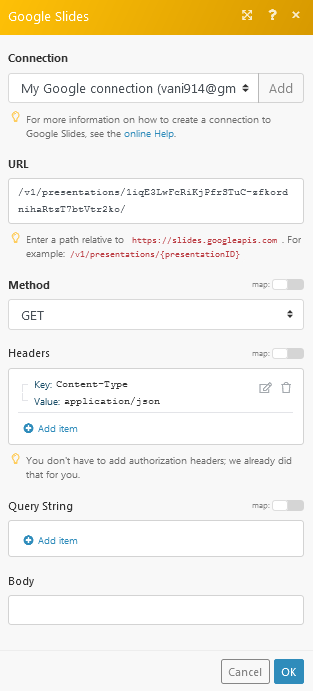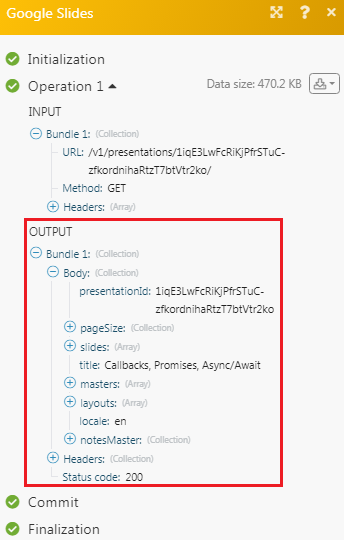| Active with remarks |
|---|
| This application needs additional settings. Please follow the documentation below to create your own connectionUnique, active service acces point to a network. There are different types of connections (API key, Oauth…). More. |
With Google Slides modulesThe module is an application or tool within the Boost.space system. The entire system is built on this concept of modularity. (module - Contacts) More in Boost.spaceCentralization and synchronization platform, where you can organize and manage your data. More IntegratorPart of the Boost.space system, where you can create your connections and automate your processes. More, you can create, update, list, and/or delete presentations and upload images to presentations in your Google Slides account.
In order to use Google Slides with Boost.space Integrator, you must have a Google account with Google Slides or Presentations in your Google Drive. If you do not have a Google account, you can create one at https://accounts.google.com .
![[Note]](https://docs.boost.space/wp-content/themes/bsdocs/docs-parser/HTML/css/image/note.png) |
Note |
|---|---|
|
Boost.space Integrator‘s use and transfer of information received from Google APIs to any other app will adhere to Google API Services User Data Policy. |
To establish the connection:
-
Log in to your Boost.space Integrator account, add a Google Slides moduleThe module is an application or tool within the Boost.space system. The entire system is built on this concept of modularity. (module - Contacts) More to your scenarioA specific connection between applications in which data can be transferred. Two types of scenarios: active/inactive. More, and click Create a connection.
-
Optional: In the Connection name field, enter a name for the connection.
-
Click the Sign in with Google button and select your Google account.
-
Review the access information and click Allow.
You have successfully established the connection. You can now edit your scenario and add more Google Slides modules. If your connection requires reauthorization at any point, follow the connection renewal steps here.
TriggersEvery scenario has a trigger, an event that starts your scenario. A scenario must have a trigger. There can only be one trigger for each scenario. When you create a new scenario, the first module you choose is your trigger for that scenario. Create a trigger by clicking on the empty module of a newly created scenario or moving the... when a new presentation is created or updated.
|
Connection |
|
|
Watch |
Select the option to watch the presentations:
|
|
Limit |
The maximum number of presentations Boost.space Integrator should return during one scenario execution cycleA cycle is the operation and commit/rollback phases of scenario execution. A scenario may have one or more cycles (one is the default).. |
Retrieves a list of all presentations.
|
Connection |
|
|
Folder ID |
Choose the folder location whose presentations you want to list. |
|
Limit |
The maximum number of presentations Boost.space Integrator should return during one scenario execution cycle. |
Gets the latest version of a specified presentation.
|
Connection |
|
|
Presentation ID |
Select the Presentation ID whose details you want to retrieve. |
Gets the latest version of the specified page or of the thumbnail of a page in the presentation.
|
Connection |
|
|
Presentation ID |
Select the Presentation ID whose page details you want to retrieve. |
|
Page Object ID |
Select the slide whose page object details you want to view. |
|
Show Page Thumbnail |
Select the checkbox if you want to view page thumbnail information. |
Creates a new presentation by replacing all tags like {{Name}}, {{Email}} in a templateTemplates are predefined scenarios that you can expand and customize to create new scenarios. You can then share these with friends and colleagues. More with provided data.
|
Connection |
|
|
Title |
Enter a name for the presentation. |
|
Copy a Presentation |
Select the option if you are copying an existing presentation:
|
|
Copy of Existing Presentation ID |
Enter the Path or Presentation ID of an existing presentation which you want to copy. This field appears if you are creating the presentation By Mapping. |
|
Presentation ID |
Select the Presentation ID whose template you want to copy. |
|
Values |
Add the values: Tag Enter the tag you want to replace in the presentation. For example, {{Name}} Replaced Value Enter the value with which the existing tag is to be replaced. For example, if a string |
|
Folder ID |
Select the folder where you want to store or add the presentation. |
|
Shared |
Select if you want to share the presentation. |
|
Sharing with Other’s Email Address |
Enter the email address with whom you want to share the presentation. If you are not entering an email address and selecting only shared field, the presentation is shareable to anyone. |
Uploads an image with provided data.
|
Connection |
||||
|
Presentation ID |
Select the Presentation ID where you want to add an image. |
|||
|
Values |
Add the values: Tag Enter the tag to which you want to add the URL. Image URL Enter the path or URL to the image you want to upload.
|
Refreshes the chart data stored in a presentation specified by ID.
|
Connection |
|
|
Presentation ID |
Select the Presentation ID whose chart you want to refresh. |
|
Chart Object ID |
Select the Chart you want to refresh. |
Performs an arbitrary authorized API call.
|
Connection |
||||
|
URL |
Enter a path relative to https://developers.google.com/slides/. E.g.
|
|||
|
Method |
Select the HTTP method you want to use: GET to retrieve information for an entry. POST to create a new entry. PUT to update/replace an existing entry. PATCH to make a partial entry update. DELETE to delete an entry. |
|||
|
Headers |
Enter the desired request headers. You don’t have to add authorization headers; we already did that for you. |
|||
|
Query String |
Enter the request query string. |
|||
|
Body |
Enter the body content for your API call. |
Using an API call you can get the presentation details for the presentation ID you have entered:
You can find the presentation ID in the URL when you the open the presentation in Google Slides.

The following API call returns the presentation details:

Matches of the search can be found in the module’s Output under BundleA bundle is a chunk of data and the basic unit for use with modules. A bundle consists of items, similar to how a bag may contain separate, individual items. More > Body > presentationId.
In our example, the requested presentation details were returned:


![[Important]](https://docs.boost.space/wp-content/themes/bsdocs/docs-parser/HTML/css/image/important.png)